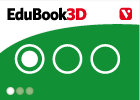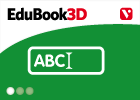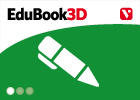Cargando...
Recursos educativos
-
Nivel educativo
-
Competencias
-
Tipología
-
Idioma
-
Tipo de medio
-
Tipo de actividad
-
Destinatarios
-
Tipo de audiencia
-
Creador
-

Tria la resposta. El fetus
EduBook Organización
- 1440 visitas
Tria la resposta correcta a la pregunta següent: En quina època de l'embaràs l'embrió passa a anomenar-se fetus i ja s'assembla a un nadó?
-

Investiga. El nèctar
EduBook Organización
- 1444 visitas
L'insecte que visita una flor té una recompensa: el nèctar de la flor. Busca informació sobre què és el nèctar i quina funció fa. Per què els agrada tant als insectes? Mira de saber quins…
-

Relaciona. Formes d'energia
EduBook Organización
- 1445 visitas
Relaciona les diferents formes d'energia amb la seva definició: energia elèctrica energia tèrmica energia mecànica energia química energia lluminosa energia nuclear
-

Final evaluation 02 - The Middle Ages
EduBook Organización
- 1445 visitas
Between which dates did the Muslims inhabit the Iberian Peninsula?
-

Correct. Characteristics of living things
EduBook Organización
- 1442 visitas
Correct the following sentences: Non-living things are active. . Spontaneous movement is a characteristic of plants. . Living things do not interact with each other. . Animals grow towards the light. .
-

Answer. Sponges, cnidarians and echinoderms
EduBook Organización
- 1437 visitas
Remember what you have studied in this section and answer the questions: Where do sponges live? What do cnidarians look like? What do echinoderms look like?
-

Investigate. Your birth
EduBook Organización
- 1436 visitas
Ask your parents about your birth. Then complete the following sentences in your notebook: I was born on ......, at ...... . I was born after ...... months and ...... weeks of pregnancy. My birth was…
-

Find out. Nectar
EduBook Organización
- 1450 visitas
Flowers produce nectar to attract insects. Look for information about nectar. What is its function? Why are insects attracted to it? Find out if any other animals are attracted to the nectar in flowers.
-

Final self-evaluation 02 - Plant reproduction
EduBook Organización
- 1442 visitas
Decide if the following statements are true or false: The male reproductive organs of the flower are the stamens. ➝ Pollen grains have millions of spermatozoids inside them. ➝ Seed-buds have an…
-

True/false. Chemical reactions
EduBook Organización
- 1440 visitas
Decide if the following statements are true or false: Chemical reactions are processes that turn certain substances into other liquids. ➝ Coal is an example of a combustible substance. ➝ Oxidation…
Te estamos redirigiendo a la ficha del libro...













